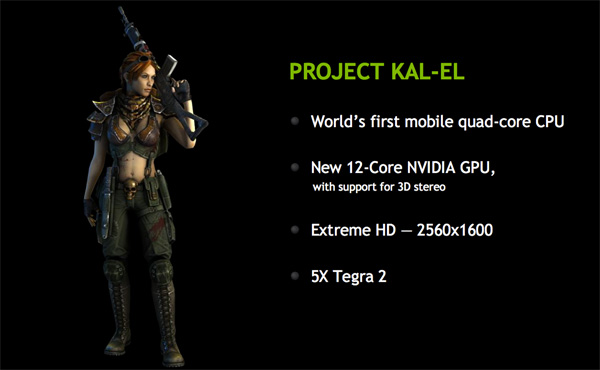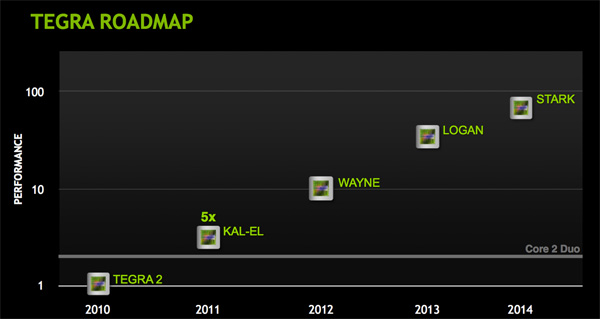NVIDIA's Project Kal-El: Quad-Core A9s Coming to Smartphones/Tablets This Year
by Anand Lal Shimpi on February 15, 2011 9:05 PM ESTIf there's any one takeaway from both CES and Mobile World Congress this year it's that NVIDIA is unequivocally a player in the SoC space. With design wins from LG, Motorola and Samsung, NVIDIA may not have the entire market but it has enough of it to be taken seriously.
In our Optimus 2X Review I mentioned that it looked like NVIDIA was going to be moving to a 6-month product cycle in the SoC space. The intention is to out execute its competitors frequently enough that they are either forced out of the market or into making a mistake trying to keep up. It's the same strategy that NVIDIA used to compete with 3dfx almost fifteen years ago.
I wrote that in 2011 NVIDIA would release Tegra 2 followed by the Tegra 2 3D (a higher clocked version of the Tegra 2 with support for 3D content) and finally the Tegra 3 before the end of the year. While it wasn't too long ago that NVIDIA was telling people about its 6-month product cycle, things have changed.
The Tegra 2 3D looks like it's not going to happen. The higher clocked SoC is not currently in any designs that are in the pipeline. There are Tegra 2 based smartphones and tablets that are due out this year, but nothing based on T25/AP25 as far as I can tell.
Although the middle of the roadmap changed, it's the end of 2011 that's sort of amazing. Internally NVIDIA referred to this chip as Tegra 3, and externally we expected it at the tail end of 2011 with devices launching in Q1 2012.
NVIDIA got the first silicon back from the fab 12 days ago. While the chip may end up being called Tegra 3 or some variation of that, for now NVIDIA refers to it as Project Kal-El. Named after young superman (or Nicholas Cage's son), Kal-El will be sampling this year and shipping in devices as early as August 2011.
The Roadmap
I must say that this is highly unlikely behavior for a SoC manufacturer. Qualcomm recently announced its dual-core MSM8960 would be sampling in Q2 2011 and shipping in devices starting next year. NVIDIA is announcing sampling starting sometime very soon (the chip is only 12 days old after all) and device availability before the end of the year.
NVIDIA went on to be even more specific. Tablets based on Kal-El will be available starting August 2011, while smartphones will be available this Christmas and into the first half of next year. This is either NVIDIA over committing to an unrealistic future or the most aggressive schedule we've seen from an SoC vendor yet. NVIDIA won some points by actually pulling off the coup with Tegra 2 this year, however it's still too early to tell whether we'll see the whole thing repeated again just 9 months from now. I'm willing to at least give NVIDIA the benefit of the doubt here.
It doesn't stop with Kal-El either. NVIDIA is committing to a yearly refresh of its architecture, NVIDIA quantifies the move from Tegra 2 to Kal-El as a 5x increase in performance. By 2012 we'll have Wayne, which doulbes performance over Kal-El. Then we've got another 5x increase over Wayne with Logan in 2013. The furthest NVIDIA is willing to go out is 2014 with Stark, at roughly a doubling of the performance offered by Logan.
The baseline reference point is Tegra 2, which NVIDIA expects Stark to outperform by a factor of 100x. NVIDIA also expects Kal-El to be somewhere in the realm of the performance of a Core 2 Duo processor (more on this later).
Based on the cadence that NVIDIA presented, it looks like every year we'll either get a doubling or 5x increase in performance over the previous year. Kal-El is one of those 5x years, followed by a doubling with Wayne, 5x again with Logan and a doubling with Stark. Now the performance axis in the chart above is really vague, so end users will likely not see 5x Tegra 2 with Kal-El, but they will see something tangible at least.












76 Comments
View All Comments
jjj - Tuesday, February 15, 2011 - link
does this " The architecture will first ship in a quad-core, 40nm version" mean Kal-El will get a 28 nm version too?softdrinkviking - Wednesday, February 16, 2011 - link
I think the assumption is that a future iteration of the architecture introduced with Kal-El will be a die shrink. (probably the 2x one that will be implemented in 2012)At least that is what I am assuming until Nvidia proves me wrong.
michael2k - Tuesday, February 15, 2011 - link
Even if they can't sustain it, I love that they're trying. Is this the powerhouse behind the NGP?nafhan - Wednesday, February 16, 2011 - link
No, the NGP sounds like it'll be using an SGX GPU. So, that means it'll probably use Samsung or TI.Lucian Armasu - Wednesday, February 16, 2011 - link
The only other company that has announced a quad core chip for this year is Freescale. I believe they have a 1 Ghz quad core Cortex A9 chip.dleonseng - Tuesday, February 15, 2011 - link
first paragraph:"...NVIDIA may not have the entire market but it has enough of it to be take{N} seriously."
NCM - Wednesday, February 16, 2011 - link
Re "...are simply due to learnings it had in the design of Tegra 2s..." (second page)"Learning" means the process of acquiring knowledge, not the things one has learned; it doesn't have a plural form.
Instead try: "...are simply due to things it learned in the design of Tegra 2..."
DarkUltra - Tuesday, February 15, 2011 - link
Who cares about four cores? I want Android UI running on the GPU. Most people who see an Android phone will immediately do two things: swipe through home screens and scroll through the app list. If they see lag and choppiness they inevitably compare to the iPhone and assume that the phone as a whole is not as fast and responsive; end-of-story for them.The restrictions of the iphone and Apples iTunes lock-in barely makes it worth it.
A5 - Tuesday, February 15, 2011 - link
Honeycomb supposedly helps with that and presumably Tegra 3 will be running that or Ice Cream.dcollins - Wednesday, February 16, 2011 - link
Isn't Android 2.3 GPU accelerated?Also, part of the problem is the carriers software doesn't have great performance. My Droid 2 is running Liberty 1.5 and the home screens, app drawer, and contacts all scroll smoothly. Not so with the stock ROM, which stuttered a lot and got slower over time. I suggest anyone with a Droid 2 or Droid X check out Liberty.